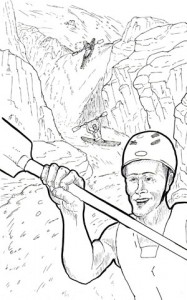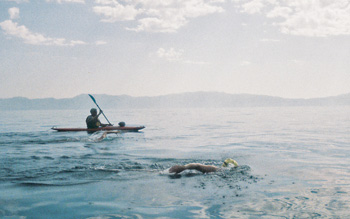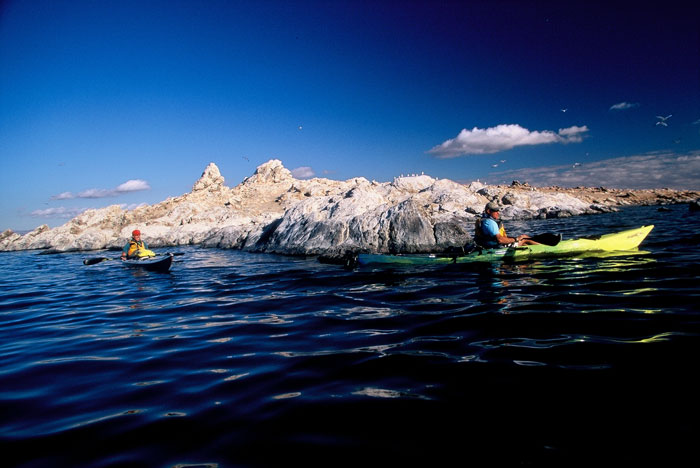- Exploring Lava Beds National Monument - 07/15/2024
- Wandering Through Washington - 03/21/2024
- Striding Through Socal Sun, Storms and Snow - 12/27/2023

Illustration by Christopher Hampson

Illustration by Christopher Hampson
A selection from the new book,
Yosemite Epics: Tales of Adventure from America’s Greatest Playground, compiled by ASJ contributor Matt Johanson.
Suffering from arthritis, famed climber Royal Robbins recalls taking a break from making first ascents of Yosemite’s big walls in 1980 to make the first descent by kayak of the Middle Fork of the San Joaquin with Reg Lake and Doug Tompkins.
Royal Robbins left his mark on Yosemite by leaving as few marks as possible. While achieving historic first ascents including Half Dome’s Northwest Face and El Capitan’s Salathé Wall, the pioneer promoted an ethic of clean climbing, shunning the overuse of bolts and pitons. Climbers now enjoy scaling Yosemite classics free of excessive alterations thanks largely to the efforts of Robbins and his like-minded contemporaries, though the onset of arthritis led him to redirect his energy toward kayaking in the late 1970s.
Today the Middle Fork of the San Joaquin River carries a rating of Class V+ for extreme danger, dropping nearly 5,000 feet over 32 harrowing miles. Robbins, 45, and companions Doug Tompkins and Reg Lake attempted the first descent over five days in September of 1980. The wild mountain river that plunges over waterfalls and carves through giant boulders in narrow canyons provided the adventure of a lifetime, and the whitewater journey also helped Robbins discover an even greater reward. —Matt Johanson
Climbing was my number one pursuit, but I got into river running because I developed arthritis. My wrists and ankles started hurting and when I went climbing they would hurt even more. I had been pretty lucky up until then in that I had done a lot and avoided any nasty injuries like broken bones, though it was obvious I couldn’t continue climbing like I had been. But I could still boat and paddle, even though it was painful. Kayaking offered an outlet for my energies and my drive to do new things in the outdoors.
The Middle Fork of the San Joaquin River, a trans-Sierra traverse, was a virgin route. Doug Tompkins had a small plane and we flew over the area to look at the river in June of 1981. Clearly it was a serious gorge, very impressive with big walls. In the spring it’s just crazy down there, whitewater from beginning to end. You don’t want water that big where the drop is so steep. So I went up to take another look with Reg Lake in August from the highest possible put-in. We boated about six miles of the upper part below Shadow Lake down to Devil’s Postpile National Monument. A week later, we came back with Doug and committed ourselves to the rest of the experience.
As a team we were balanced. Reg was the kayaking expert. Doug, with his intense drive, was the engine. I was the brakeman, to keep the pace leisurely and avoid mistakes. I’d been kayaking somewhat, but I didn’t consider myself an expert by any means. It’s a good thing we didn’t know what we were doing, because a shrewder evaluation of the situation might have led us to say no. Our advantage was that we didn’t know enough about it to be as terrified as we should have been.
We put in at Devil’s Postpile. The San Joaquin begins as a small river, high in the mountains amid pines and firs. We weren’t used to that, because in kayaking most of your boating is in the foothills where there’s brush. The water started at about 300 cubic feet per second, pretty small but it was big enough to float our boats and give us thrills. The first day got us partway down the gorge past the Postpile and below Rainbow Falls, around which we portaged. When the gradient got too steep, we’d get out of the boats, cross slabs, lower our boats into the river and rappel down, using rock climbing skills. Frankly, we were surprised to get so far without carrying the kayaks more. The grade was steep but forgiving, allowing us to stay on the river in our boats in places where we didn’t think we could do that, based on the map. So it was a gift.
On the second day we approached Waterslide Fall, which was a serious section because if you screw it up, you’re liable to go over an 80-foot waterfall. We would have carried our boats past it, but there were steep walls on either side. Doug went first and came within five feet of the falls, but you have to come that close to reach an eddy where you can stop. He was hard to scare. I was much easier to frighten. I was terrified of that run. It was really something I would have avoided if I could have, but we didn’t have any choice. We had to run it. My heart was pounding, but we each reached the eddy where we could get out and carry our boats around the falls to put in again.
The next big question was the Great Corridor, where the river drops past Balloon Dome into a section called the Granite Crucible. At the beginning of this, we rappelled from a piton past First Falls. Then we had to stop at a drop called Double Chute because we couldn’t see all of it from above. We thought it was probably okay, and it probably was, but if it isn’t, you’re liable to die. That gets your attention. Taking a chance like that is not the way I was raised! We had brought climbing equipment, so if necessary we could have tried to escape the canyon that way, though the walls were thousands of feet high. Finally Reg saved the day by climbing out of his kayak onto a boulder right at the big drop. He looked over the other side and said, “It’ll go!” Those were good words to hear. Otherwise one of us probably would have gone anyway, sooner or later. We would have got tired of paddling around in circles in the pool above.
In the beautiful San Joaquin River gorge, we saw things that we never saw anywhere else before or since. We kayaked under a giant chock stone. The river actually ran under a boulder in the canyon. That was the first time I’d ever seen that. We stopped each night next to the river wherever we could see places for sleeping bags and slept under the stars. We packed light, very much like on a climb, and took just nuts, gorp and salami to eat. You feel lucky to have whatever is in your hands, and there’s always steak waiting for you at the end.
We descended a series of pool-drop rapids on the last day. You go over a drop, reach a quiet pool where you can recover, then you go for a ways until another drop, and another quiet pool. That was pretty nice, compared to a continuous flow with no pools and no place to recover. We ran into the mouth of Mammoth Pool Reservoir and paddled a few miles on the beautiful blue water to the takeout.
I thought the gorge would be a trade route. I’m surprised it hasn’t become more popular. That speaks of its difficulty and challenge. I compare it to the Salathé Wall of El Capitan.That was a great adventure too. This was an adventure like that in that we didn’t know what was coming for sure, and there was some risk. If I had to give up all the climbs I’ve done except for one, it would be Salathé Wall. If I had one river to keep, I would choose the Middle Fork of the San Joaquin, because of the scenery, the adventure, the friendship, the beauty and everything it involved. To us, it was a privilege to be in such a place.
My specialist was pretty pessimistic and didn’t say anything about the prospect of my arthritis healing. I was missing my Eskimo roll because of pain in my wrists, and I wondered if it would get worse and force me to stop kayaking, too. But luckily my arthritis went away after a few years and I returned to climbing classic moderates. These days I enjoy both climbing and kayaking. I love the sense of freedom that these sports provide. Every time I climb or paddle, I think I’m lucky to be able to do this. I appreciate these things so much more than I would have if I’d never lost them.
I can’t say I have the cure, but I do know that my improvement coincided with my decision not to let arthritis rule my life. I think laughter is the best medicine and we laughed a lot on that trip. I’m a deep believer that the more optimistic you are, the better things go for you. I’ve been able to achieve things most people consider extraordinary by the power of that principle. If you live with an adventurous, positive attitude, you’re happier, you make more friends and you’re healthier.
________________________________________________________________
Royal Robbins, now 76, lives in Modesto with his wife Liz.
“Yosemite Epics: Tales of Adventure from America’s Greatest Playground” is published by Dreamcatcher Publishing. Author-signed copies are available at their website, www.dreamcatch- erpublishing.com, for $16.95.













